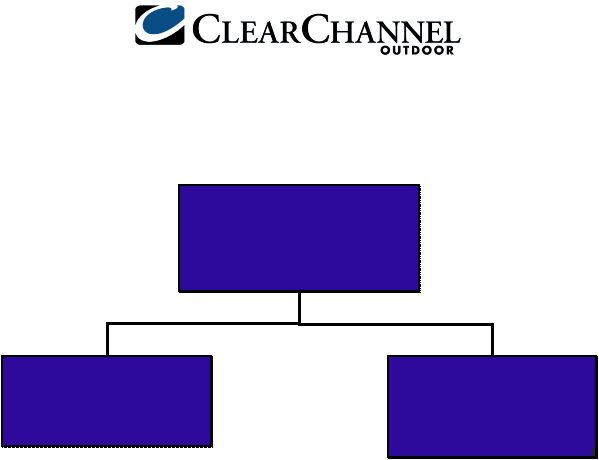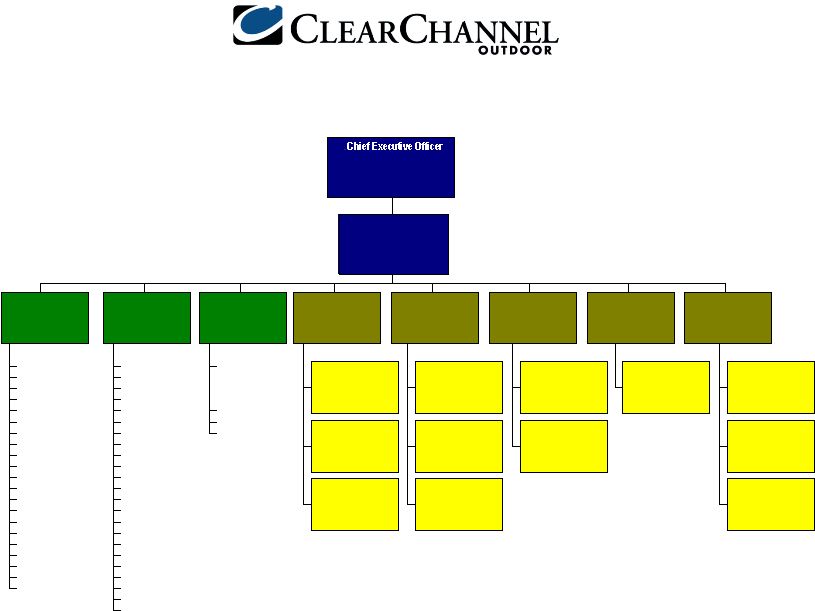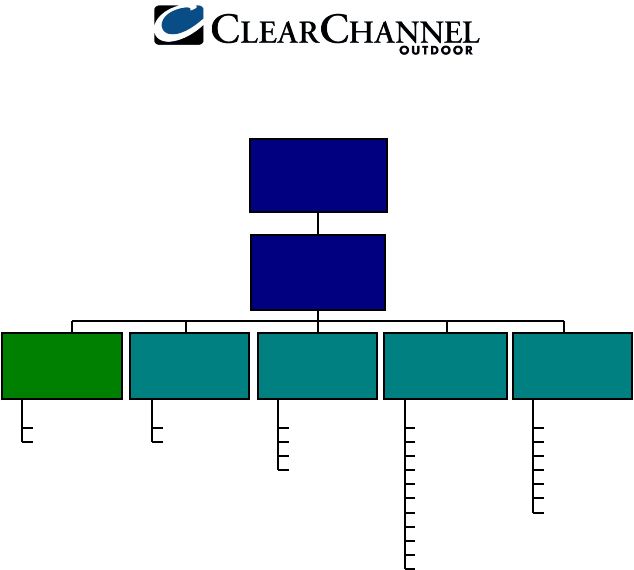CORRESP: A correspondence can be sent as a document with another submission type or can be sent as a separate submission.
Published on December 11, 2009

December 11, 2009
VIA EDGAR
U.S. Securities and Exchange Commission
Division of Corporation Finance
100 F Street, N.E.
Washington, D.C. 20549
Attention: Mr. Kyle Moffatt
| Re: | Clear Channel Outdoor Holdings, Inc. (the Company) |
| Form 10-K for the fiscal year ended December 31, 2008, filed March 2, 2009 |
| File No. 001-32663 |
Dear Mr. Moffatt:
This letter is in response to the Staffs comments to the Company by its letter dated October 19, 2009 relating to the above-referenced Form 10-K. Our responses are referenced to the applicable Staff comment and the paragraph numbering used for each response set forth below corresponds to the paragraph numbering used in the Staffs comment letter.
Form 10-K for the fiscal year ended December 31, 2008
Critical Accounting Policies, page 55
| 1. | We note your response to comment one of our letter dated August 28, 2009. Your statement that the existence of segment managers responsible for the Americas and International operations and the nature of the activities of each is not sufficient evidence to support your conclusion regarding your operating segments. In this regard, we note from your response that your CODM regularly reviews significantly detailed information for each market within the Americas and each country in International, including revenues, operating expenses, OCF and OCF margins. Therefore, we continue to believe all of the markets listed on pages 22 and 23 within the Clear Channel Outdoor Americas reports under Tab III. Performance Tracker Reports and each individual country within the Clear Channel Outdoor International reports under the Board of Directors tab are each separate operating segments under SFAS 131. |
If you believe any of the above operating segments can be aggregated under paragraph 17 of SFAS 131, please provide us your analysis and financial information for all periods presented in
Securities and Exchange Commission
December 11, 2009
Page 2 of 5
your filing. In addition to your analysis of paragraph 17.a through 17.e, please provide us with an analysis that includes historical and projected revenue, gross margins, gross margin percentages, OCF, OIBDAN and respective percentages, along with any other information you believe would be useful for each of your operating segments to help us understand how these operations are economically similar. Please also address any differences in the trends these financial indicators depict (e.g. if gross profit margin is decreasing for one operation and increasing for another).
Similarly, if you believe any of these operating segments are not required to be reported separately under paragraphs 18 21 of SFAS 131, please provide us an analysis to support your position.
The Company has determined that its CODM is its CEO, Mark Mays, who is responsible for allocating resources and assessing the performance of each segment. The Companys operating structure consists of approximately 50 markets (business units) in its Americas segment and approximately 40 countries (business units) in its International segment. The Company has a segment manager (as discussed in ¶14 of SFAS 131) for the Americas and International segments to manage the significant number of business units. The segment manager for the Americas is Paul Meyer, CEO of Americas, while the segment manager for International is William Eccleshare, CEO of International. The Companys CODM generally does not interact with the regional presidents or business unit managers when making operational or resource allocation decisions concerning the segments. Rather, he holds regular periodic meetings with Paul and William to discuss the performance of their segments. Paul and William do not have the necessary power or authority to perform the CODM function and neither is a board member.
The function of the CODM (as discussed in ¶12 of SFAS 131) is to allocate resources and assess the performance of the segments of an enterprise. At the direction of our CODM, each segment manager together with their regional presidents and business unit managers, executes each segments business strategy. For example, during preparation of the annual operating and capital expenditure budgets, the CODM provides each segment with budget objectives. The CODM does not participate in the budget process at the region or business unit level. The CODM relies on the segment managers to ensure their overall budget adheres to the enterprise budget objectives. The segment managers, with input from their regional presidents and business unit managers, are responsible for establishing budgets to achieve the objectives for their respective segments outlined by the CODM. The operating and capital expenditure budgets are consolidated at the segment level and presented to the CODM for approval. After the budget is approved by the CODM, the segment managers are given discretion for maximizing the resources allocated to their segments, allowing them to shift resources between business units. The segment managers determine how to most efficiently deploy Company resources within their segments. The segment managers cannot approve or direct capital expenditures for the other segment or have any influence on the other segment.
Securities and Exchange Commission
December 11, 2009
Page 3 of 5
As discussed above, we have two segment managers, Paul Meyer and William Eccleshare. Paul has three regional presidents that report to him and William has four regional presidents that report to him. Underneath the regional presidents are the business unit managers.1 Pauls compensation is based on the performance of the Americas segment and Williams compensation is based on the performance of the International segment. The financial performance metrics establishing compensation targets for our segment managers are set by our CODM. In addition, separate corporate offices in Phoenix and London exist to support the day-to-day operations of the Americas and International segments, respectively. Services such as legal, financial planning and analysis, certain accounting and human resource services are located in both of these corporate offices.
Our segment management structure is subdivided into regions in order to provide a reasonable span of control of our segment management. Our regions are not based on unique economic characteristics of certain geographic areas. For example, the regional concept in the Companys International segment did not exist two years ago. From time to time, our regions and markets are reconfigured in order to optimize the span of control of our segment management team. This flexibility in regional structure is made possible as our business unit operations are not impacted by the regional structure changes and continue to offer the same advertising inventory and use the same resources. The CODM does not assess performance at the regional level and does not review the segment on a regional basis for making resource allocation decisions. Rather, the regions act as a tool for the segment managers to hold their regional presidents accountable.
As discussed above, capital expenditure budgets are approved by the CODM for the entire segment, with each segment manager having discretion over allocation of the budget across the business units. Discrete capital projects are initiated at the business unit level and reviewed up the chain of command through the regional presidents and segment managers. These capital projects are approved (within certain limits as defined by the corporate development office in San Antonio) by the segment managers. Discrete projects exceeding $25 million require board approval. However, these projects are cyclical in nature based on the economic environment in which the Company is operating.
We considered whether other members of management and the board of directors were part of the CODM function as discussed in ¶12 of SFAS 131. Although our CEO relies on input from our segment managers as well as meets with our board of directors, it is our CEO who is responsible for making the strategic, operational and resource allocation decisions of the Company. The Companys board of directors reviews the Companys operating results at the segment level. The board of directors does not review the operating results of individual regions or business units within each segment, except for discrete matters that require board approval.
| 1 | See Appendix A for an organizational chart. |
Securities and Exchange Commission
December 11, 2009
Page 4 of 5
| 2. | We note your response to comment two of our letter dated August 28, 2009. With respect to Clear Channel Outdoor Americas, since each market is an operating segment, it appears that at a minimum, each market would be a separate reporting unit pursuant to SFAS 142. Please revise or advise. |
We believe that Clear Channel Outdoor Americas is an operating segment.
****
In connection with responding to the Staffs comments, the Company acknowledges that:
| | the Company is responsible for the adequacy and accuracy of the disclosure in the filings; |
| | Staff comments or changes to disclosure in response to Staff comments do not foreclose the Commission from taking any action with respect to the filings; and |
| | the Company may not assert Staff comments as a defense in any proceeding initiated by the Commission or any person under the federal securities laws of the United States. |
If you have any questions regarding these responses, please contact Herb Hill at (210) 822-2828.
| Very truly yours, | ||
| /s/ Herbert W. Hill, Jr. |
||
| Herbert W. Hill, Jr. Senior Vice President and Chief Accounting Officer |
||
| cc: | Randall T. Mays |
| Chief Financial Officer |



Appendix A
- Corporate Organizational Chart CEO Clear Channel Mark Mays (CODM) CEO Clear Channel Mark Mays (CODM) President and CEO Clear Channel Outdoor Americas Paul Meyer (Segment Manager) President and CEO Clear Channel Outdoor Americas Paul Meyer (Segment Manager) President and CEO Clear Channel Outdoor International William Eccleshare (Segment Manager) President and CEO Clear Channel Outdoor International William Eccleshare (Segment Manager) |

Appendix A - Americas Organizational Chart CC Airports / Interspace CC Taxi Media Albuquerque Chicago Dallas/Fort Worth El Paso Fort Smith Houston Las Vegas Los Angeles New Orleans Phoenix Portland Reno Sacramento San Antonio San Diego San Francisco Seattle Tucson Wichita Regional President Western United States Gene Leehan Branded Cities CC Malls CC Spectacolor CC Canada Akron/Canton Atlanta Boston Cleveland Daytona Beach Des Moines Indianapolis Jacksonville Memphis Miami Milwaukee Minneapolis New York Ocala Orlando Philadelphia Salisbury Tampa Bay Wash. D.C./Balt. Regional President Eastern United States Tim Stauning Brazil Curitiba Sao Paulo Rio de Janeiro Chile Mexico Peru Regional President Latin America Augusto Claux Senior VP Real Estate California,Nevada,Utah. Dave McWalters Senior VP Real Estate Southern United States Joe Garner Senior VP Real Estate Northern United States Dan Pomeroy Executive VP Real Estate / Public Aff. Americas Bryan Parker Senior VP Deputy General Coun Americas Laura Tonceff Senior VP Assoc. General Coun Western United States Martin Felli Assoc. General Coun Litigation Deb Sirower Executive VP General Council Americas David Clark VP Operations Quantum Structure Dennis Tuggle Director of Safety & Training Jim Poage Executive VP Operations Americas Charlie Turner VP Controller Mark Rowe Executive VP Chief Financial Officer Americas Chet Kwasniak Senior VP Creative, Marketing, Public Relations Tony Alwin VP Sales Technology Trisha Dall VP Research Andrew Marcus Executive VP Sales and Marketing Americas Rocky Sisson President and CEO Clear Channel Outdoor Americas Paul Meyer .. Clear Channel Mark Mays . |

Appendix
A - International Organizational Chart Greece International Neon Chief Financial Officer Dir. Corp. Development International Jonathan Bevan Ireland UK Regional President UK, Ireland Barry Sayer Belgium France Italy Spain Regional President Southern Europe Hubert Janvier Denmark Finland Netherlands Norway Norway Cinema Poland Romania Russia & Baltics Sweden Switzerland Turkey Regional President Northern & Eastern Europe Rickard Hedlund Australia/New Zealand China Hong Kong India Japan Singapore Thailand Regional President Asia - Pacific Mark Thewlis President and CEO Clear Channel Outdoor International William Eccleshare Chief Executive Officer Clear Channel Mark Mays - |